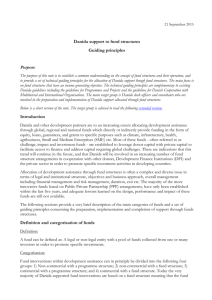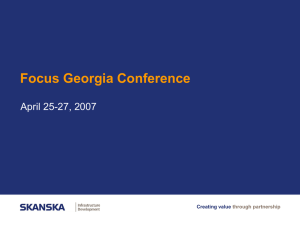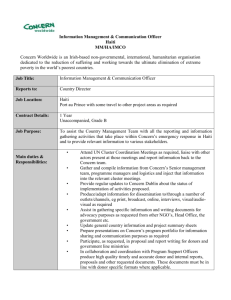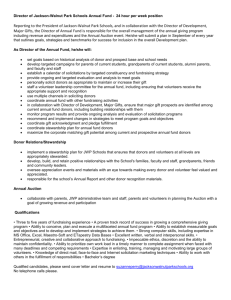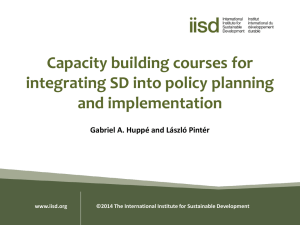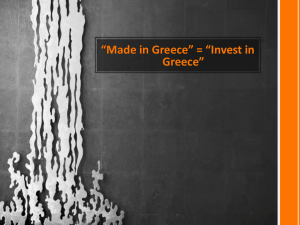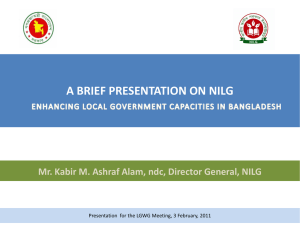word - Aid Management Guidelines
advertisement
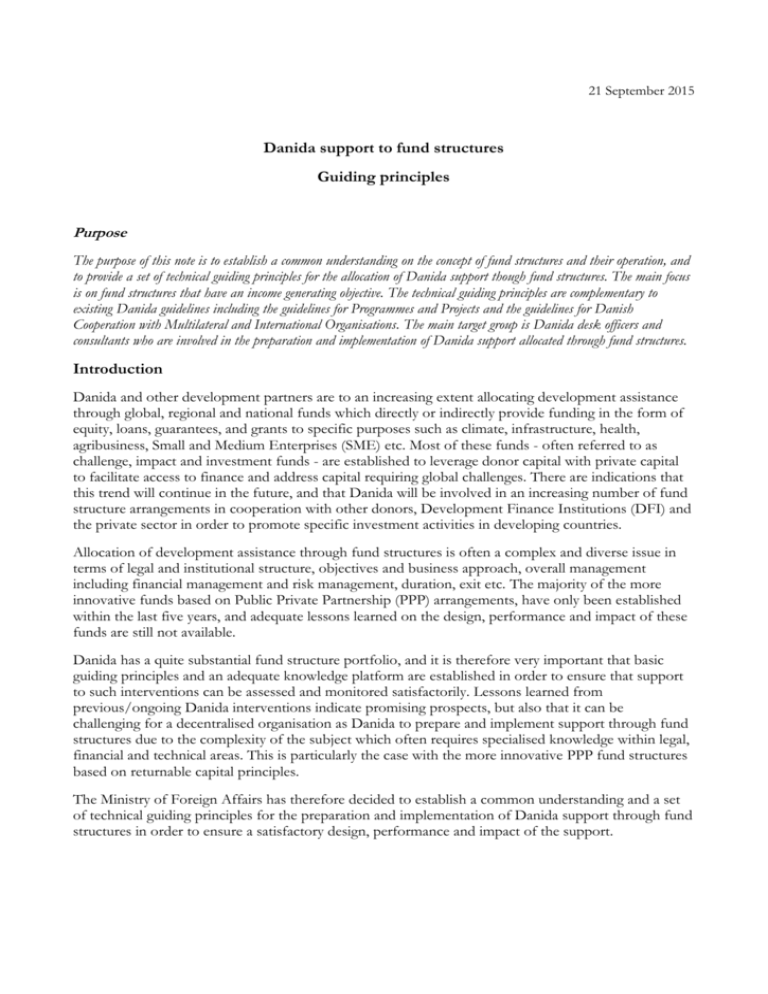
21 September 2015 Danida support to fund structures Guiding principles Purpose The purpose of this note is to establish a common understanding on the concept of fund structures and their operation, and to provide a set of technical guiding principles for the allocation of Danida support though fund structures. The main focus is on fund structures that have an income generating objective. The technical guiding principles are complementary to existing Danida guidelines including the guidelines for Programmes and Projects and the guidelines for Danish Cooperation with Multilateral and International Organisations. The main target group is Danida desk officers and consultants who are involved in the preparation and implementation of Danida support allocated through fund structures. Introduction Danida and other development partners are to an increasing extent allocating development assistance through global, regional and national funds which directly or indirectly provide funding in the form of equity, loans, guarantees, and grants to specific purposes such as climate, infrastructure, health, agribusiness, Small and Medium Enterprises (SME) etc. Most of these funds - often referred to as challenge, impact and investment funds - are established to leverage donor capital with private capital to facilitate access to finance and address capital requiring global challenges. There are indications that this trend will continue in the future, and that Danida will be involved in an increasing number of fund structure arrangements in cooperation with other donors, Development Finance Institutions (DFI) and the private sector in order to promote specific investment activities in developing countries. Allocation of development assistance through fund structures is often a complex and diverse issue in terms of legal and institutional structure, objectives and business approach, overall management including financial management and risk management, duration, exit etc. The majority of the more innovative funds based on Public Private Partnership (PPP) arrangements, have only been established within the last five years, and adequate lessons learned on the design, performance and impact of these funds are still not available. Danida has a quite substantial fund structure portfolio, and it is therefore very important that basic guiding principles and an adequate knowledge platform are established in order to ensure that support to such interventions can be assessed and monitored satisfactorily. Lessons learned from previous/ongoing Danida interventions indicate promising prospects, but also that it can be challenging for a decentralised organisation as Danida to prepare and implement support through fund structures due to the complexity of the subject which often requires specialised knowledge within legal, financial and technical areas. This is particularly the case with the more innovative PPP fund structures based on returnable capital principles. The Ministry of Foreign Affairs has therefore decided to establish a common understanding and a set of technical guiding principles for the preparation and implementation of Danida support through fund structures in order to ensure a satisfactory design, performance and impact of the support. 2 The following sections provide a brief description of the main categories of funds and a set of guiding principles concerning the preparation, implementation and completion of support through funds structures. Definition and categorisation of funds Definition: A fund can be defined as: A legal or non-legal entity with a pool of funds collected from one or many investors in order to promote specific investments. Categorisation: Fund interventions within development assistance can in principle be divided into the following four groups: 1) Non-commercial with a programme structure; 2) non-commercial with a fund structure; 3) commercial with a programme structure; and 4) commercial with a fund structure. Today the very majority of Danida supported fund interventions are based on a fund structure meaning that the fund has its own legal structure with own management or a contracted fund manager, and this guidance note is consequently focusing on the fund structure categories (category 2 and 4 in the below matrix). With regards to objectives and development orientation Danida supported fund structures could also be categorised into the following four main groups of which this guidance note mainly concerns group 2 - 4: 1. Traditional facilities and challenge funds: This group comprises a large mix of non-profit facilities and challenge funds with strong development objectives. They are typically established as a facility attached to an existing organisation or as a stand-alone project, but some are also established with own legal and institutional structure. These facilities and funds are almost entirely based on donor grant support, which is reallocated to selected project/activities. The contribution from the end beneficiaries varies depending on the type of intervention, but the 3 grant element normally constitutes the very majority of the total mobilised capital. An example could be an advocacy facility, which Danida supports in a number of countries or the Skills Development Fund in Ghana. Some of the large multilateral facilities and challenge funds may have several windows, e.g. a traditional grant based window for public infrastructure, capacity building etc., and a more private and commercial PPP based window. Some of the new multilateral facilities and funds, e.g. the Global Environmental Facility and the Green Climate Fund, are addressing both traditional grant based and PPP based development activities; 2. Investment oriented challenge or revolving funds: Typically non-profit funds with strong development objectives but also some income generating objectives in order to achieve a certain level of sustainability of the fund, e.g. operational sustainability. The funds are mainly donor financed and they are typically providing guarantees, loans, matching grants, TA etc. to facilitate investments including the mobilisation of complementary financing from commercial banks and beneficiaries. These funds are typically revolving and the generated profit will be returned into the fund. Examples could be REACT under the African Enterprise Challenge Fund (grants and interest free loans) or the aBi Trust (grants, loans and guarantees) in Uganda; 3. Traditional impact funds: Funds that have balanced development and profitability objectives in order to achieve a positive but low financial return. The funds are typically financed by donors, DFIs and philanthropic investors, and they are typically providing loans, guarantees or equity capital to facilitate investments including bank lending and contribution from beneficiaries. These funds often have a separate donor financed capacity building facility for capacity building of involved financial institutions or end beneficiaries. The funds will typically be based on returnable capital principles, meaning that some of the investors will realise their investments after an indicated number of years. Donor contributions have normally been reported to DAC and will therefore be revolved or reinvested in other development activities. An example could be the African Guarantee Fund registered in Mauritius and operated from Kenya; 4. Commercial impact or investment funds: Funds with strong profitability objectives within a framework of agreed development objectives. The funds are typically financed by donors, DFIs and private investors (mainly institutional), and they will normally provide equity and loans to get a commercially acceptable return. Depending of the type and character of investments, public capital (donors and DFIs) may typically be leveraged by private capital by a factor 1 - 5. The funds are based on returnable capital principles, meaning that the DFIs and private investor will realise their investments after a given period, whereas the donor investments will be revolved or reinvested in other development activities. An example could be the Danish Climate Investment Fund managed by IFU, or the Global Climate Partnership Fund registered in Luxembourg and operated by an external recruited fund manager. Examples of the four groups of fund structures can be found here. A mapping of the Danida supported funds structures have identified about 30 funds, which can be categorised under group 2 – 4 (investment oriented challenge funds, traditional impact funds and commercial impact/investment funds) which are of particular relevance in relation to the guiding principles stated in this paper. Total Danida contribution to these ongoing fund structures is currently about DKK 3.2 billion, and the size of the portfolio is increasing steadily due to a continuous flow of new commitments. For further information concerning fund structure overview and mapping see here. Key messages The below guiding principles concern all types of fund structures, but the main focus is on PPP based impact and investment funds. 4 Context Development partners are to an increasing extent allocating development assistance through various kinds of income generating impact and investment funds based on PPP, and this trend is likely to continue in the future; These fund mechanism’ are often very complex in terms of a) legal, institutional and financial structure; b) objectives, strategic approach and implementation modalities; and c) investment horizon and exit. Use of specialised internal and external expertise is therefore required during preparation, implementation and completion; Most of these fund initiatives have only been initiated within the last five years and well-tested methodologies, data and lessons learned concerning the design, performance and impact are unfortunately still inadequate; Allocation of development assistance through various impact and investment fund structures requires strong coordination within the Ministry in order to ensure adequate quality assurance during preparation, implementation and completion. Guiding principles – how to improve design, implementation and exit The below mentioned 15 guiding principles comprise some of the main issues that should be addressed during the preparation and implementation of the fund structure interventions. It should be emphasised that all the below issues already need to be addressed at an early stage of the preparation as they to a large extent become part of a fairly irreversible legal and institutional framework that has to be agreed upon before the start of the implementation. 1. The responsible units should always consult head-office expertise (GRV and TAS) at a very early stage of the preparation. During implementation GRV and TAS should be consulted when specific issues need to be addressed. 2. Planned new commitments to fund structures should be presented to the Danida Programme Committee. Planned commitments to fund structure interventions (as part of a larger programme or as a stand-alone project) should be presented to the Programme Committee for consideration before detailed design and preparation measures are initiated. 3. Support should preferably be allocated through an existing fund structure. It is important to carefully consider possible options of using existing funds structures, particularly in cases where the Danida commitment is relatively small. Adequate existing funds, including funds supported by other donors, are often available and could be a better solution rather than establishing a new fund. It is by all means a complex and time-consuming task to establish a new fund; 4. Ensure that the responsible Danida representative/office has the required capacity to engage with fund intervention on a long-term perspective. Support to impact and investment funds is a long-term commitment with a preparation and implementation horizon of not less than 8 – 10 years and often much longer. The preparation, start-up, implementation and completion/winding-up phases often take much longer time than expected, and the time frame for the entire process therefore goes far beyond normal Danida programme cycles; 5. Ensure that all statutory documents, agreements and operational guidelines, budgets etc. are carefully assessed before approval and signing of cooperation agreements. The 5 basic legal documents and operational guidelines in relation to impact and investment funds are often very complex and difficult to assess. Misinterpretations could have serious implications, and it is therefore normally necessary to consult legal expertise (e.g. the Danish Government’s Lawyer/Kammeradvokaten and/or lawyers in the country of registration) and financial expertise. Ensure that adequate safeguards are incorporated into the legal documents; 6. Clarify whether Danida should only be a fund facilitator providing grants for TA, capacity building etc. and/or be a direct capital investor in the fund. Direct capital investment is normally a much more complicated approach throughout the entire preparation, implementation and completion process; 7. Ensure that the defined balance between the development objectives and the commercial objectives, as well as the related strategic implementation approaches, are well understood and agreed upon between the involved parties before signing of agreements and start-up of implementation. These issues include e.g. poverty orientation versus profitability an risk, geographical and thematic approach, size and type of investment, local capacity building/networking etc.; 8. An overall exit strategy should be defined during preparation and regularly reassessed during implementation. Exit of fund structures can be very complicated, and the exit will often take much longer than expected. It therefore important that the preparation of exit strategies become and integrated part of the entire design and preparation process. It will normally be necessary to regularly reassess the exit strategy during implementation. 9. Assess carefully the framework of the fund manager contract. Most challenge and investment funds are managed by a contracted fund manager. It is important to carefully assess the legal, managerial and financial issues of the fund manager contract including tasks and responsibilities, fee structure, performance criteria, procurement procedures for recruitment of fund manager, contract duration, safeguards for contract renegotiations etc.; 10. Ensure that clear leverage and additionality targets are defined and can be measured. Measuring the mobilisation and additionality of private capital in PPP impact and investment fund arrangements is a fundamental and complicated issue to address, and internationally adopted methodologies and guidelines are still not available; 11. Ensure that the mix of financial products to be offered by the fund fully support the overall objectives and strategies of the fund. The principal financial products offered by funds comprise equity, various types of loans, guarantees, grants and TA. The type of financial products and services to be offered have a significant impact on the institutional structure, strategic approach and operation of the fund; 12. Ensure that the risk sharing and the profit distribution procedures of the fund have been carefully assessed and agreed upon. Donors should be prepared to take more risk compared with DFIs and first of all private investors, but the risk sharing principles should be fair and the needs well documented. Danida will normally not support new fund initiatives which are based on a First Loss Cover principle; 13. Ensure that the defined M&E and reporting requirements are realistic and well adapted to the objectives of the funds, the defined responsibilities of the fund manager, and the expectations of the private investors. Donors may often have too ambitious M&E and reporting requirements compared with the private investor groups. However, it should also be 6 legitimate for donors to request impact assessments when a fund’s mission include development objectives, partly financed by donor funds; 14. Ensure that Danida directly or indirectly become an active player in the governance structure of the fund, at least during annual meetings. Assess the advantages and disadvantages of direct or indirect Danida participation in boards and committees. Boards and committees in investment and impact funds often require specialised expertise which Danida does not have in-house. Participation in board and committees is also time-requiring. I may therefore be better to delegate possible board and committee participation to other investors or external expertise; 15. Ensure that adequate donor harmonisation and coordination is established in relation to the interventions of the fund. Donors, private investors and fund managers may in certain cases give inadequate priority to donor coordination and favour own interests. Key issues to be addressed during preparation and implementation The below figure indicates some of the key issues that need to be assessed during the preparation and implementation process of the fund structure: Before Programme Committee General objectives and strategic approach, Theory of Change, additionality etc. Fund structure framework Capacity of key stakeholders Available essential documents Possible participation in governance structures Types of financial products Risk sharing and profit distribution procedures Donor coordination Duration and exit Before Cooperation Agreement and start-up All basic statutory documents, agreements, operational guidelines Defined balance between development and commercial objectives and strategic approach Participation in governance structure Indicators, incl. leverage and additionality, and M&E system Fund manager contract incl. tender Modalities of financial products and services provided Exit strategy Implementation Exit Assessment of progress and performance reports Participation in governance meetings Major strategic and operational issues Possible reassessment of fund manager contract Possible reassessment of exit strategy Donor coordination Exit procedures and transfer of remaining funds/proceeds Reporting on completion, lessons learned and impact Critical issues While donor supported funds vary widely in terms of legal and institutional setup, objectives, strategic approach, products/services, target groups etc., a number of common critical issues of importance for the design and performance of the funds can be identified. Impact and commercial funds that are based on public-private partnership are often the most complex and challenging to assess. The critical issues to be considered include: Legal and institutional issues Funds are often based on a very complex legal and institutional structure, which can be challenging to assess without legal and financial expertise. These issues include the legal documents including 7 statutes/articles of association, the country of registration and the related regulatory framework, the management structure and the delegation of responsibility e.g. in relation to contracted fund managers, risk and waterfall distribution, access to information etc. The structure and content of the documents vary considerably and it therefore difficult to provide any specific guidance of what to look for. However, the following issues should always be carefully assessed: Country of registration and regulatory framework: Many developing countries do not have a satisfactory, transparent and internationally recognised legal and regulatory framework in relation to the establishment, operation and closure of funds, and that can provide challenges in relation to the establishment of national or regional funds, e.g. in Africa. Many international funds are registered in countries that provide favourable tax conditions for the fund and the investors, and that can be a reputational risk for donors although there may be a number of relevant legal and financial reasons for registering a fund in one of these countries. Many donor supported impact and investment funds are e.g. registered in Mauritius and Luxembourg, which have a satisfactory regulatory framework, but also may be considered as “tax havens”; Institutional and managerial structure: Some funds are established as a full-fletched organisation with own procedures and staff, where as other funds are operated by externally recruited fund managers. Both models have advantages and disadvantages, but most funds are operated by a specialised external fund manager, which in most cases would be the most appropriate solution - particularly for funds with a temporary purpose of max 10 – 15 years. It is normally faster and less complicated/requiring to establish a fund that is operated by a specialised external fund manager. However, the fund manager model may be relatively expensive over time, and it may be challenging to re-tender a fund manager contract without generating some turbulence within the fund and in relation to the clients. The procurement procedures to be applied for the recruitment of the fund manager should be carefully assessed in cooperation with HCP. The fund manager fee is normally based on a percentage of the capital under management and composed by a fixed rate plus various performance fees. However, the fee structure is a complex issue, as the fee depends on a number of factors including the investment environment, the type of financial products, the size of the fund etc. The issue should always be carefully assessed prior to the signing of the contract, and it should be possible to reconsider the fee structure regularly during the implementation. Participation in fund governance meetings: Influencing and monitoring through a fund structure is very different from a programme structure. It is important that Danida as an investor understands this difference and plays an active role in the fund governance structure in order to influence and monitor. Traditional reviews and direct donor dialogue with the management will normally not be an opportunity in relation to a fund structure. Fund structure influence can be executed through Annual Meetings, board or committee meetings etc. The role and responsibility of Danida should be determined on a case by case basis, but it is important that it is based on clear strategic considerations and priorities. In certain cases it may be sufficient to participate in Annual Meetings, whereas in other cases Danida should try to play a more active role through participation in boards or committees. However, it has to be emphasised that participation in boards and committees may be very time consuming and require specialised expertise which Danida does not have in-house. Danida may therefore consider delegating board or committee work to other investors or external expertise. Access to information: Access to and dissemination of information can be a sensitive issue in relation to funds based on PPP. The fund may be regulated under a company act with restrictive regulations concerning dissemination of information, whereas public investors 8 (including Danida) also have to adhere to the law on access to public information. Danida has already experienced certain challenges on how to handle confidential information and public requests on access to information. However, in spite of these challenges, Danida should always require solid and relevant reporting from the fund manager, and ensure that it receives and analyses all information that is made available for the investors. Objectives and strategic approach: Impact and investment funds are often based on PPP arrangements where the involved investor groups have agreed on some overall development objectives but at the same time have different expectations and priorities concerning a number of strategic and operational issues. It will often be challenging to prepare clear and operational objectives and strategies that all investors can fully support. The involved parties will therefore have to accept compromises that can ensure a strategic and operational framework that can satisfy both basic development objectives and commercial objectives. These strategic considerations and agreements need to be completed up-front before the investors pay in their contributions and the fund starts its operation. The strategic considerations comprise a number of issues including the geographical areas for the interventions (e.g. a broad and flexible geographical approach contra a more focused and challenging approach, or low-income countries only contra all DAC countries), the target groups and expected poverty orientation, the types of investments, the type of financial products (loans, equity, guarantees, grants) etc. The challenges in a PPP investment fund is indicated in the below example. Donors, DFIs and private institutional investors have agreed to jointly invest in agri-business development through a global agri-business investment fund established for the purpose. The investors have agreed that the fund should promote sustainable agribusiness investments in developing countries in order to promote sustainable economic growth, employment generation, competitiveness and food security. However, the donors would like to ensure: a) that at least 50% of the funds are invested in LDCs in Africa and the remaining in Lower Middle-income Countries, b) that the investments ensure strong small-holder inclusion, c) that the investment portfolio be composed by relatively small investments which can be well integrated into the local business environment and do no harm on related local businesses, d) a strong CSR focus including environment, gender, decent employment etc. The DFIs and private investors on the other hand would like: a) less restrictions on geographical focus and LDC focus in order to improve average performance of the investments, reduce risk and facilitate exit, b) relatively fewer and larger projects in order to reduce transaction costs, c) a financial return of at least 12% which will exclude a number of investment opportunities relevant for the donors. It is obvious that the investor groups need to establish a stronger consensus regarding expectations and priorities. Leverage and additionality A key purpose of PPP based impact and investment funds is to leverage donor funds with private capital and ensure high additionality. The leverage factor indicates the factor that the public capital has been multiplied with mobilised private capital, e.g. 1:4. Additionality indicates the percentage of the private capital that is mobilised and invested due to the public funds, considering that a certain percentage, e.g. 50%, of the mobilised private capital would have been invested in similar activities anyhow. The attribution of a Danida support would then be: Danida support * leverage factor * additionality. It is obvious that PPP financing mechanism can facilitate the mobilisation of private capital through various measures that can mitigate the risk of the private investors and ensure acceptable return. The challenge is : 1) how to define and calculate the mobilised private capital (and hereby the leverage factor) and 2) how to determine a well-documented additionallity factor? It is important that the applied leverage and additionality factors are based on internationally acknowledged methodologies and standards in order to ensure that the data are well documented and internationally comparable. Investment funds and fund managers are often indicating leverage figures, which are undocumented and appear to be highly overoptimistic. Double counting may also be a risk when aggregating donor reported figures on the mobilisation of private capital. 9 Principles for risk sharing and distribution of funds: Impact and investment funds that are based on PPP arrangements with returnable capital apply very diverse and complex procedures for risk sharing and distribution of loss and profit in relation to the public and private investors. The distribution models, often described as “distribution waterfall” defines the order in which funds will be distributed and it will often indicate that certain investors have priority of payment compared with others within the same funds. It is obvious that donors should be prepared to carry the highest risk in PPP based impact and investment fund arrangements in order to ensure optimal leverage of private capital, but the principles should also be fair. Many of the investments funds established in recent years are e.g. based on a First Loss Cover principle, where the donors according to agreed principles will cover the first losses. The problem with this model is that it in certain situations tends to allocate too much risk to the donors, whereas the DFIs and the private investors are left with a limited and controllable risk that may be smaller than in their ordinary business activities. As a general principle Danida will not participate in new investment fund arrangements that are based on First Loss Cover principles, and Danida has in the Danish Climate Investment Fund and the Danish Agribusiness Fund instead applied a Preferred Return Principle which ensures a more fair risk distribution. Expertise should always be consulted in relation to the assessment of risk sharing and distribution waterfall. Financial products offered by funds The main financial products offered by funds include equity and loan capital, guarantees, grants and TA. Most funds are offering several products and services but are normally focusing on 1 or 2. The type of financial products and services offered have a significant impact on a number of factors of the structure and operation of the fund including: the strategic approach; the size of the fund, the cost structure; the number and size of the investments; whether the fund will invest directly or indirectly through other funds; the profitability, the risk management procedures; the fund manager contract etc. It is important to understand these relations between the type of financial products and the structure and operations of the funds. Result framework, monitoring and reporting It is often difficult to find the right result framework, M&E and reporting balance in PPP based impact and investment fund arrangements. Donors have often very ambitious M&E and reporting requirements, whereas fund managers and private investors typically prioritise a lean M&E and reporting mechanism that focuses on financial performance indicators and only to limited extent include economic and social development indicators. Again it is necessary to compromise and fine an adequate M&E and reporting balance that is acceptable to all parties. Most information has to be collected from the end target group which typically will be private sector stakeholders with limited M&E experience and limited commitment to spending time and resources on M&E and reporting. Donors should also be aware that private registered impact and investment funds normally are subject to strict regulations concerning dissemination of information. Information is basically disseminated according to the stated legal and managerial procedures, and an individual donor (investor) cannot just ask for information on its own. Reference is also made to the above issue concerning the law of access to public information.
